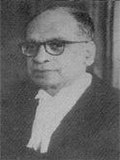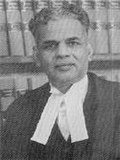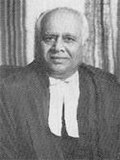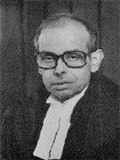Chief Justice of India
 From Wikipedia - Reading time: 15 min
From Wikipedia - Reading time: 15 min
| Chief Justice of India | |
|---|---|
| Head of highest judicial authority in India | |
 Insignia of the SCI | |
since 11 November 2024 | |
| Supreme Court | |
| Type | Chief Justice |
| Status | Presiding Judge of Supreme Court of India |
| Abbreviation | CJI |
| Residence | 5, Krishna Menon Marg, Sunehri Bagh, New Delhi, India[1] |
| Seat | Supreme Court of India, New Delhi, India |
| Nominator | Outgoing Chief Justice of India, generally on the basis of Seniority |
| Appointer | President of India |
| Term length | Until the age of 65[2] |
| Constituting instrument | Constitution of India (under Article 124) |
| Formation | 26 January 1950 |
| First holder | H. J. Kania (1950–1951)[3] |
| Succession | 6th (on the Indian order of precedence) |
| Salary | ₹280,000 (US$3,300) (per month)[4] |
| Website | sci.gov.in |
| This article is part of a series on |
| Judiciary of India |
|---|
 |
| Law of India |
The chief justice of India (CJI) is the chief judge of the Supreme Court of India and the highest-ranking officer of the Indian judiciary. The Constitution of India grants power to the President of India to appoint, as recommended by the outgoing chief justice in consultation with other judges, (as envisaged in Article 124 (2) of the Constitution)[5] the next chief justice, who will serve until they reach the age of 65 or are removed by the constitutional process of impeachment.
As per convention, the successor suggested by the incumbent chief justice is most often the next most senior judge of the Supreme Court. However, this convention has been broken twice. In 1973, Justice A. N. Ray was appointed, superseding three senior judges, and in 1977 when Justice Mirza Hameedullah Beg was appointed as Chief Justice, superseding Justice Hans Raj Khanna.
As head of the Supreme Court, the chief justice is responsible for the allocation of cases and appointment of constitutional benches that deal with important matters of law.[6] In accordance with Article 145 of the Constitution of India and the Supreme Court Rules of Procedure of 1966, the chief justice has to allocate work to the other judges who are bound to refer the matter back to them (for re-allocation) in any case where they require it to be looked into by another group of experienced judges.
On the administrative side, the chief justice carries out functions of maintenance of the roster, appointment of court officials, and general and miscellaneous matters relating to the supervision and functioning of the Supreme Court. The chief justice is de facto chancellor of National Law School of India University and Visitor of National Law University, Delhi.
The 51st and present chief justice is Sanjiv Khanna. He was sworn in as Chief Justice on 11 November 2024.[7]
Appointment
[edit]As the incumbent chief justice approaches retirement, the Ministry of Law and Justice seeks a recommendation from the incumbent chief justice. Consultations with other judges might also take place. The recommendation is then presented to the prime minister, who will advice the president in the matter of appointment.[8]
Removal
[edit]Article 124(4) of the Constitution of India lays down the procedure for the removal of a judge of the Supreme Court, which is applicable to chief justices as well. Once appointed, the chief justice remains in office until age 65. There is no fixed tenure provided in the constitution. [citation needed] He can be removed only through a process of removal by Parliament as follows:
A Judge of the Supreme Court shall not be removed from his office except by an order of the President passed after an address by each House of Parliament supported by a majority of the total membership of that House and by a majority of not less than two-thirds of the members of that House present and voting has been presented to the President in the same session for such removal on the ground of proved misbehaviour or incapacity.
— Article 124(4), Constitution of India, [9]
Acting president
[edit]The President (Discharge of Functions) Act, 1969 specifies the chief justice of India shall act as the president of India in the event of the offices of both the president and the vice president being vacant.[10] When President Zakir Hussain died in office, Vice President V. V. Giri acted as the president. Later, V. V. Giri resigned as the vice president, the chief justice, Justice Mohammad Hidayatullah became the acting president of India. As per the convention, the senior most judge of the Supreme Court become the acting chief justice. When the newly elected president took office a month later, Justice Hidayatullah reverted as the chief justice of India.
Remuneration
[edit]The Constitution of India gives the power of deciding remuneration as well as other conditions of service of the chief justice to the Parliament of India. Accordingly, such provisions have been laid down in The Supreme Court Judges (Salaries and Conditions of Service) Act, 1958.[11][12] This remuneration was revised in 2006–2008 after the Sixth Central Pay Commission's recommendation.[13] According to the Seventh pay commission, in 2016, the salary was revised.[14]
List of chief justices of India
[edit]| † | Died in office |
| ‡ | Resigned |
| No. | Name (birth–death) |
Image | Start of Term | End of Term | Length of Term | Parent High Court | Appointed by (President of India) |
Ref. |
|---|---|---|---|---|---|---|---|---|
| 1 | Harilal Jekisundas Kania (1890–1951) |

|
26 January 1950 | 6 November 1951† | 1 year, 284 days | Bombay | Rajendra Prasad | [15] |
| 2 | Mandakolathur Patanjali Sastri (1889–1963) |

|
7 November 1951 | 3 January 1954 | 2 years, 57 days | Madras | [16] | |
| 3 | Mehr Chand Mahajan (1889–1967) |

|
4 January 1954 | 22 December 1954 | 352 days | Lahore | [17] | |
| 4 | Bijan Kumar Mukherjea (1891–1956) |

|
23 December 1954 | 31 January 1956‡ | 1 year, 39 days | Calcutta | [18] | |
| 5 | Sudhi Ranjan Das (1894–1977) |

|
1 February 1956 | 30 September 1959 | 3 years, 241 days | Calcutta | [19] | |
| 6 | Bhuvaneshwar Prasad Sinha (1899–1986) |

|
1 October 1959 | 31 January 1964 | 4 years, 122 days | Patna | [20] | |
| 7 | Pralhad Balacharya Gajendragadkar (1901–1981) |

|
1 February 1964 | 15 March 1966 | 2 years, 42 days | Bombay | Sarvepalli Radhakrishnan | [21] |
| 8 | Amal Kumar Sarkar (1901–2001) |

|
16 March 1966 | 29 June 1966 | 105 days | Calcutta | [22] | |
| 9 | Koka Subba Rao (1902–1976) |

|
30 June 1966 | 11 April 1967‡ | 285 days | Hyderabad | [23] | |
| 10 | Kailas Nath Wanchoo (1903–1988) |

|
12 April 1967 | 24 February 1968 | 318 days | Allahabad | [24] | |
| 11 | M. Hidayatullah (1905–1992)[a] |

|
25 February 1968 | 16 December 1970 | 2 years, 294 days | Bombay | Zakir Hussain | [25] |
| 12 |
Jayantilal Chhotalal Shah |

|
17 December 1970 | 21 January 1971 | 35 days | Bombay | V. V. Giri | [26] |
| 13 | Sarv Mittra Sikri (1908–1992) |

|
22 January 1971 | 25 April 1973 | 2 years, 93 days | Bar Council | [27] | |
| 14 | Ajit Nath Ray (1912–2009) |

|
26 April 1973 | 28 January 1977 | 3 years, 276 days | Calcutta | [28] | |
| 15 | Mirza Hameedullah Beg (1913–1988) |

|
29 January 1977 | 21 February 1978 | 1 year, 24 days | Allahabad | Fakhruddin Ali Ahmed | [29] |
| 16 | Yeshwant Vishnu Chandrachud (1920–2008) |

|
22 February 1978 | 11 July 1985 | 7 years, 139 days | Bombay | Neelam Sanjiva Reddy | [30] |
| 17 | Prafullachandra Natwarlal Bhagwati (1921–2017) |

|
12 July 1985 | 20 December 1986 | 1 year, 161 days | Gujarat | Zail Singh | [31] |
| 18 | Raghunandan Swarup Pathak (1924–2007) |

|
21 December 1986 | 18 June 1989‡ | 2 years, 209 days | Allahabad | [32] | |
| 19 | Engalaguppe Seetharamiah Venkataramiah (1924–1997) |

|
19 June 1989 | 17 December 1989 | 181 days | Karnataka | Ramaswamy Venkataraman | [33] |
| 20 | Sabyasachi Mukharji (1927–1990) |

|
18 December 1989 | 25 September 1990† | 281 days | Calcutta | [34] | |
| 21 | Ranganath Misra (1926–2012) |

|
26 September 1990 | 24 November 1991 | 1 year, 59 days | Orissa | [35] | |
| 22 | Kamal Narain Singh (1926–2022) |

|
25 November 1991 | 12 December 1991 | 17 days | Allahabad | [36] | |
| 23 | Madhukar Hiralal Kania (1927–2016) |

|
13 December 1991 | 17 November 1992 | 340 days | Bombay | [37] | |
| 24 | Lalit Mohan Sharma (1928–2008) |

|
18 November 1992 | 11 February 1993 | 85 days | Patna | Shankar Dayal Sharma | [38] |
| 25 | Manepalli Narayanarao Venkatachaliah (born 1929) |

|
12 February 1993 | 24 October 1994 | 1 year, 254 days | Karnataka | [39] | |
| 26 | Aziz Mushabber Ahmadi (1932–2023) |

|
25 October 1994 | 24 March 1997 | 2 years, 150 days | Gujarat | [40] | |
| 27 | Jagdish Sharan Verma (1933–2013) |

|
25 March 1997 | 17 January 1998 | 298 days | Madhya Pradesh | [41] | |
| 28 | Madan Mohan Punchhi (1933–2015) |

|
18 January 1998 | 9 October 1998 | 264 days | Punjab and Haryana | K. R. Narayanan | [42] |
| 29 | Adarsh Sein Anand (1936–2017) |

|
10 October 1998 | 31 October 2001 | 3 years, 21 days | Jammu and Kashmir | [43] | |
| 30 | Sam Piroj Bharucha (born 1937) |

|
1 November 2001 | 5 May 2002 | 185 days | Bombay | [44] | |
| 31 | Bhupinder Nath Kirpal (born 1937) |

|
6 May 2002 | 7 November 2002 | 185 days | Delhi | [45] | |
| 32 | Gopal Ballav Pattanaik (born 1937) |

|
8 November 2002 | 18 December 2002 | 40 days | Orissa | A. P. J. Abdul Kalam | [46] |
| 33 | Vishweshwar Nath Khare (born 1939) |

|
19 December 2002 | 1 May 2004 | 1 year, 134 days | Allahabad | [47] | |
| 34 | S. Rajendra Babu (born 1939) |

|
2 May 2004 | 31 May 2004 | 29 days | Karnataka | [48] | |
| 35 | Ramesh Chandra Lahoti (1940–2022) |

|
1 June 2004 | 31 October 2005 | 1 year, 152 days | Madhya Pradesh | [49] | |
| 36 | Yogesh Kumar Sabharwal (1942–2015) |

|
1 November 2005 | 13 January 2007 | 1 year, 73 days | Delhi | [50] | |
| 37 | Konakuppakatil Gopinathan Balakrishnan (born 1945) |

|
14 January 2007 | 11 May 2010 | 3 years, 117 days | Kerala | [51] | |
| 38 | Sarosh Homi Kapadia (1947–2016) |

|
12 May 2010 | 28 September 2012 | 2 years, 139 days | Bombay | Pratibha Patil | [52] |
| 39 | Altamas Kabir (1948–2017) |

|
29 September 2012 | 18 July 2013 | 292 days | Calcutta | Pranab Mukherjee | [53] |
| 40 | Palanisamy Sathasivam (born 1949) |

|
19 July 2013 | 26 April 2014 | 281 days | Madras | [54] | |
| 41 | Rajendra Mal Lodha (born 1949) |

|
27 April 2014 | 27 September 2014 | 153 days | Rajasthan | [55] | |
| 42 | Handyala Lakshminarayanaswamy Dattu (born 1950) |

|
28 September 2014 | 2 December 2015 | 1 year, 65 days | Karnataka | [56] | |
| 43 | Tirath Singh Thakur (born 1952) |

|
3 December 2015 | 3 January 2017 | 1 year, 31 days | Jammu and Kashmir | [57] | |
| 44 | Jagdish Singh Khehar (born 1952) |

|
4 January 2017 | 27 August 2017 | 235 days | Punjab and Haryana | [58] | |
| 45 | Dipak Misra (born 1953) |

|
28 August 2017 | 2 October 2018 | 1 year, 35 days | Orissa | Ram Nath Kovind | [59] |
| 46 | Ranjan Gogoi (born 1954) |

|
3 October 2018 | 17 November 2019 | 1 year, 45 days | Gauhati | [60] | |
| 47 | Sharad Arvind Bobde (born 1956) |

|
18 November 2019[61] | 23 April 2021 | 1 year, 156 days | Bombay | [62] | |
| 48 | Nuthalapati Venkata Ramana (born 1957) |

|
24 April 2021 | 26 August 2022 | 1 year, 124 days | Andhra Pradesh | [63] | |
| 49 | Uday Umesh Lalit (born 1957) |

|
27 August 2022 | 8 November 2022 | 73 days | Bar Council | Droupadi Murmu | [64] |
| 50 | Dhananjaya Yeshwant Chandrachud (born 1959) |

|
9 November 2022 | 10 November 2024 | 2 years, 1 day | Bombay | [65] | |
| 51 | Sanjiv Khanna (born 1960) |

|
11 November 2024 | Incumbent | 143 days | Delhi | [66] |
See also
[edit]- Collegium system
- Supreme Court of India
- High courts of India
- Tribunals in India
- Judiciary of India
- Constitution of India
- List of chief justices of India
- National Judicial Appointments Commission
- List of landmark court decisions in India
Current Judiciary
[edit]Notes
[edit]- ^ Also served as acting President of India and Vice President of India
References
[edit]- ^ "Delhi confidential: Mutual Praise". 24 August 2021. Archived from the original on 19 April 2022. Retrieved 19 April 2022.
- ^ "Supreme Court of India - CJI & Sitting Judges". Archived from the original on 5 July 2015. Retrieved 4 July 2015.
- ^ "Supreme Court of India Retired Hon'ble the Chief Justices' of India". Archived from the original on 29 June 2015. Retrieved 4 July 2015.
- ^ "Supreme Court, High Court judges get nearly 200% salary hike". Hindustan Times. 30 January 2018. Archived from the original on 30 January 2018. Retrieved 30 January 2018.
- ^ "Memorandum of procedure of appointment of Supreme Court Judges | India". Archived from the original on 9 March 2024. Retrieved 5 May 2023.
- ^ Saxena, Namit (23 December 2016). "New Captain Of The Ship, Change In Sailing Rules Soon?". Live Law. Archived from the original on 24 December 2016. Retrieved 24 December 2016.
- ^ Justice Sanjiv Khanna commences judicial proceedings as 51st CJI, thanks lawyers
- ^ Ministry of Law and Justice, Department Of Justice (8 November 2021). "MEMORANDUM SHOWING THE PROCEDURE FOR APPOINTMENT OF THE CHIEF JUSTICE OF India AND JUDGES OF THE SUPREME COURT OF INDIA". Archived from the original on 9 March 2024. Retrieved 5 May 2023.
- ^ "Article 124, Constitution of India". Vakilno1.com. Archived from the original on 26 December 2010. Retrieved 11 October 2012.
- ^ "President Discharge of Functions Act 1969 Complete Act - Citation 134059 - Bare Act | LegalCrystal". Archived from the original on 26 June 2020. Retrieved 22 January 2019.
- ^ "The High Court and Supreme Court Judges Salaries and Conditions of Service Amendment Bill 2008" (PDF). PRS India. Archived from the original (PDF) on 22 August 2017. Retrieved 23 July 2012.
- ^ "Supreme Court Judges (Salaries and Conditions of Service) Act 1958" (PDF). Ministry of Home Affairs, India. Archived from the original (PDF) on 4 January 2011. Retrieved 23 July 2012.
- ^ Archived copy (PDF). 2008. Archived from the original (PDF) on 26 June 2020. Retrieved 17 December 2018.
{{cite book}}: CS1 maint: archived copy as title (link) - ^ "Pay, Allowance and Pension | Department of Justice | India". Archived from the original on 19 August 2022. Retrieved 27 August 2022.
- ^ Cite error: The named reference
sci-hjkaniawas invoked but never defined (see the help page). - ^ "Justice M Patanjali Sastri". Supreme Court of India. Archived from the original on 28 January 2024. Retrieved 21 April 2024.
- ^ "Justice Mehr Chand Mahajan". Supreme Court of India. Archived from the original on 28 January 2024. Retrieved 21 April 2024.
- ^ "Justice Bijan Kumar Mukherjea". Supreme Court of India. Archived from the original on 28 January 2024. Retrieved 21 April 2024.
- ^ "Justice Sudhi Ranjan Das". Supreme Court of India. Archived from the original on 28 January 2024. Retrieved 21 April 2024.
- ^ "Justice Bhuvneshwar Prasad Sinha". Supreme Court of India. Archived from the original on 28 January 2024. Retrieved 21 April 2024.
- ^ "Justice P B Gajendragadkar". Supreme Court of India. Archived from the original on 28 January 2024. Retrieved 21 April 2024.
- ^ "Justice A K Sarkar". Supreme Court of India. Archived from the original on 28 January 2024. Retrieved 21 April 2024.
- ^ "Justice K Subba Rao". Supreme Court of India. Archived from the original on 28 January 2024. Retrieved 21 April 2024.
- ^ "Justice K N Wanchoo". Supreme Court of India. Archived from the original on 28 January 2024. Retrieved 21 April 2024.
- ^ "Justice M Hidayatullah". Supreme Court of India. Archived from the original on 30 April 2024. Retrieved 21 April 2024.
- ^ "Justice J C sshah". Supreme Court of India. Archived from the original on 28 January 2024. Retrieved 21 April 2024.
- ^ "Justice S M Sikri". Supreme Court of India. Archived from the original on 28 January 2024. Retrieved 21 April 2024.
- ^ "Justice A N Ray". Supreme Court of India. Archived from the original on 28 January 2024. Retrieved 21 April 2024.
- ^ "Justice M Hameedullah Beg". Supreme Court of India. Archived from the original on 28 January 2024. Retrieved 21 April 2024.
- ^ "Justice Y V Chandrachud". Supreme Court of India. Archived from the original on 28 January 2024. Retrieved 21 April 2024.
- ^ "Justice P N Bhagwati". Supreme Court of India. Archived from the original on 28 January 2024. Retrieved 21 April 2024.
- ^ "Justice R S Pathak". Supreme Court of India. Archived from the original on 28 January 2024. Retrieved 21 April 2024.
- ^ "Justice E S Venkataramiah". Supreme Court of India. Archived from the original on 28 January 2024. Retrieved 21 April 2024.
- ^ "Justice Sabyasachi Mukherjee". Supreme Court of India. Archived from the original on 30 April 2024. Retrieved 21 April 2024.
- ^ "Justice Ranganath Misra". Supreme Court of India. Archived from the original on 30 April 2024. Retrieved 21 April 2024.
- ^ "Justice K N Singh". Supreme Court of India. Archived from the original on 28 January 2024. Retrieved 21 April 2024.
- ^ "Justice M H Kania". Supreme Court of India. Archived from the original on 28 January 2024. Retrieved 21 April 2024.
- ^ "Justice L M Sharma". Supreme Court of India. Archived from the original on 28 January 2024. Retrieved 21 April 2024.
- ^ "Justice M N Venkatachaliah". Supreme Court of India. Archived from the original on 28 January 2024. Retrieved 21 April 2024.
- ^ "Justice A M Ahmadi". Supreme Court of India. Archived from the original on 28 January 2024. Retrieved 21 April 2024.
- ^ "Justice J S Verma". Supreme Court of India. Archived from the original on 28 January 2024. Retrieved 21 April 2024.
- ^ "Justice M M Punchhi". Supreme Court of India. Archived from the original on 28 January 2024. Retrieved 21 April 2024.
- ^ "Justice A S Anand". Supreme Court of India. Archived from the original on 28 January 2024. Retrieved 21 April 2024.
- ^ "Justice S P Bharucha". Supreme Court of India. Archived from the original on 28 January 2024. Retrieved 21 April 2024.
- ^ "Justice B N Kirpal". Supreme Court of India. Archived from the original on 28 January 2024. Retrieved 21 April 2024.
- ^ "Justice G B Patnaik". Supreme Court of India. Archived from the original on 28 January 2024. Retrieved 21 April 2024.
- ^ "Justice V N Khare". Supreme Court of India. Archived from the original on 28 January 2024. Retrieved 21 April 2024.
- ^ "Justice S Rajendra Babu". Supreme Court of India. Archived from the original on 28 January 2024. Retrieved 21 April 2024.
- ^ "Justice R C Lahoti". Supreme Court of India. Archived from the original on 28 January 2024. Retrieved 21 April 2024.
- ^ "Justice Y K Sabharwal". Supreme Court of India. Archived from the original on 28 January 2024. Retrieved 21 April 2024.
- ^ "Justice K G Balakrishnan". Supreme Court of India. Archived from the original on 28 January 2024. Retrieved 21 April 2024.
- ^ "Justice S H Kapadia". Supreme Court of India. Archived from the original on 28 January 2024. Retrieved 21 April 2024.
- ^ "Justice Altamas Kabir". Supreme Court of India. Archived from the original on 30 April 2024. Retrieved 21 April 2024.
- ^ "Justice P Sathasivam". Supreme Court of India. Archived from the original on 30 April 2024. Retrieved 21 April 2024.
- ^ "Justice R M Lodha". Supreme Court of India. Archived from the original on 28 January 2024. Retrieved 21 April 2024.
- ^ "Justice H L Dattu". Supreme Court of India. Archived from the original on 28 January 2024. Retrieved 21 April 2024.
- ^ "Justice T S Thakur". Supreme Court of India. Archived from the original on 28 January 2024. Retrieved 21 April 2024.
- ^ "Justice Jagdish Singh Khehar". Supreme Court of India. Archived from the original on 28 January 2024. Retrieved 21 April 2024.
- ^ "Justice Dipak Mishra". Supreme Court of India. Archived from the original on 30 April 2024. Retrieved 21 April 2024.
- ^ "Justice Ranjan Gogoi". Supreme Court of India. Archived from the original on 30 April 2024. Retrieved 21 April 2024.
- ^ "Justice Sharad Arvind Bobde takes oath as 47th CJI". The Times of India. 18 November 2019. Archived from the original on 18 November 2019. Retrieved 18 November 2019.
- ^ "Justice Sharad Arvind Bobde". Supreme Court of India. Archived from the original on 28 January 2024. Retrieved 21 April 2024.
- ^ "Justice N V Ramana". Supreme Court of India. Archived from the original on 28 January 2024. Retrieved 21 April 2024.
- ^ "Justice Uday Umesh Lalit". Supreme Court of India. Archived from the original on 28 January 2024. Retrieved 21 April 2024.
- ^ "Justice D Y Chandrachud". Supreme Court of India. Archived from the original on 29 January 2024. Retrieved 21 April 2024.
- ^ "Justice Sanjiv Khanna". Supreme Court of India. Archived from the original on 11 November 2024. Retrieved 11 November 2024.
External links
[edit] Media related to Chief Justices of India at Wikimedia Commons
Media related to Chief Justices of India at Wikimedia Commons- Official website of Supreme Court of India
 KSF
KSF
